


Pork Chop with Balsamic-Honey Glaze
Grilled Mahi Mahi with Salsa Verde
Pork Tenderloin, Grilled with Pineapple Salsa
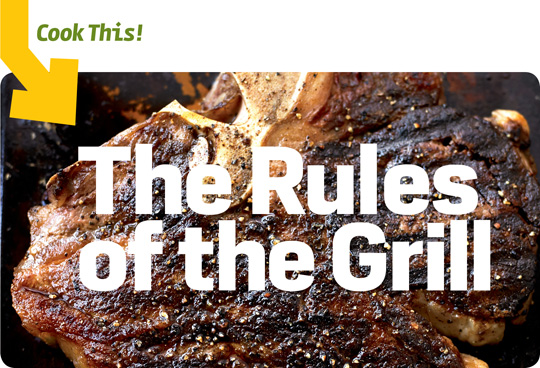
No matter who you are and how often you cook, these timeless adages of meat and fire will help you tame the flame once and for all.
1. Forget the fork.
Grill tool sets usually come with a spatula, a pair of tongs, and a scary, oversized fork for probing and pronging your food. First thing you should do is open the package and throw the fork out. The last tool you ever want to use is one that will break the surface of your food, creating an escape route for all the precious juices that are trapped inside. Spatula and tongs only.
2. Ditch the lighter fluid.
Have you ever smelled the stuff? If you have, you’d know that even the faintest residue of fluid on your food is bound to be a bad thing. Put down the squeeze bottle and pick up a charcoal chimney, a simple device that houses charcoal on top, news-paper on the bottom, and sets the whole pile ablaze with a simple flick from a lighter. Weber sells charcoal chimneys for about $15.
3. Know your zones.
A wildly hot grill can be a dangerous pro-position, especially when you have larger cuts of meat that take time to grill. Put a chicken leg or a substantial steak directly over a raging flame and you’ll char the outside before the center ever breaks room temperature. Always try to set up your grill with two temperature zones, one very hot area for searing and charring, and one cooler zone where you can cook thicker cuts slowly and thoroughly. If using a charcoal grill, gather the majority of the briquettes on one side of the grill (a technique called banking), leaving the other relatively free of direct heat. If gas is your go-to grill option, simply turn one burner on medium or high and keep another all the way down on low.
4. Rest your meat.
As tempting as it may be to take your grilled goodies from grate to plate, all meat needs time to rest before you go cutting into it. The heat of the grill has put all of the meat’s internal juices in motion; slice it open prematurely and those juices will end up on your cutting board or your plate and not in your eagerly awaiting mouth. By allowing poultry and red meat to cool, you give the juices a chance to stop swirling wildly about and eventually be reabsorbed back into the food. Big cuts of meat (thick steaks, roasts, whole chickens) need 10 minutes to rest; thinner cuts (chicken breasts, flank steak, pork tenderloin) will be ready to eat after 5.
5. Tame the temperature.
More than marinades, spice rubs, and fancy sauces, the most important skill a budding grill master needs to learn is how to cook meat and fish to its proper doneness. Cook enough and you’ll learn to gauge a steak’s internal temperature with a simple touch of the meat, as if your finger were some magical divining rod. But even the pros carry instant-read thermometers to ensure they’ve cooked their precious goods perfectly.
Harness the Heat
To get the most accurate read,insert the thermometer into the deepest part of the meat. Chicken should be cooked to an internal temperature of 160°F and pork to 140-145°F. For beef and lamb, the answers lie in the chart.
| Doneness | Internal Temperature | What It Looks Like | What It Feels Like |
| Rare | 120-125°F | Red form the center to the crust | Soft and squishy, like a sponge |
| Medium Rare | 130-135°F | Red at the center, pink everywhere else | Slightly firm but yields to gentle pressure, like a Nerf football |
| Medium | 140-145°F | Pink throughout | Barely yielding, like a racquetball |
| Medium Well | 150-155°F | Slightly pink in the center, gray everywhere else | Firm and springy, like a tennis ball |
| Well | 160°F and above | Gray throughout | Hard, like a basketball |
Marinades pack your food with flavor without the gut-busting calories of heavy sauces. They also break down tough muscle fibers and infuse your food with moisture, turning even pedestrian cuts of meat into the type of succulent fare you pay serious cash for in restaurants with linen and china. But, perhaps most importantly of all, marinades have an important health function: Research from the Food Science Institute of Kansas found that the polyphenols in marinade, drawn from a pool of herbs and spices, cut carcinogen deposits in grilled foods by up to 88 percent. That’s all the motivation we need. Seal the deal with one of these five flavor-boosting, moisture-imparting, carcinogen-killing marinades.
|
THE SMOKY Juice of 2 limes 1 cup orange juice 2 cloves garlic, minced 2 Tbsp pureed chipotle peppers ½ cup chopped cilantro Best for:
FLANK OR SKIRT STEAK, CHICKEN, PORK |
THE EASTERN ½ cup rice wine vinegar 1 cup low-sodium soy sauce 2 Tbsp fresh grated ginger 2 Tbsp brown sugar Best for:
SALMON, TUNA, PORK |
|
THE UTILITY ½ cup balsamic vinegar 2 Tbsp Dijon mustard 2 cloves garlic, minced ¼ cup olive oil 2 Tbsp chopped fresh rosemary Best for:
PORK, CHICKEN, BEEF |
THE CLUB MED 1 cup olive oil Juice of 1 lemon 1 Tbsp fresh thyme 2 cloves garlic, minced ½ tsp red pepper flakes Best for:
CHUCK, LAMB CHOPS, SHORT RIBS |
|
THE BOOZE HOUND 2 cups red wine 3 cloves garlic, minced 4 bay leaves 1 tsp black pepper Best for:
FISH, SHRIMP, CHICKEN |
KEY
|

Drop the bottled barbecue sauce! The Italians figured out a magical way to grill chicken that involves no special sauces or condiments; in fact, all you really need is a brick or two and some aluminum foil. Whoever first placed brick to backbone was smart enough to recognize that the extra weight helped press the bird evenly—and forcefully—against the grill, which translates into a juicier bird with a crisper skin—a win-win in our book.
You’ll Need:
¼ cup olive oil
Grated zest and juice of 1 lemon
1 tsp red pepper flakes
1 tsp salt
½ tsp black pepper
1 whole chicken, back removed, split in half*
2 lemons, halved
2 bricks, covered in aluminum foil
* Ask the butcher at the meat counter to do this for you.
How to Make It:
• Combine the olive oil, lemon zest and juice, pepper flakes, salt, and pepper in a large bowl, baking dish, or sealable plastic bag. Add the chicken and turn to coat. Cover the bowl or seal the bag and marinate in the refrigerator for at least 30 minutes and up to 4 hours.
• Preheat a grill (you want a nice medium-low heat). Remove the chicken from the marinade and place on the grate, skin side up. Cover the grill and cook for 10 minutes, until the chicken is lightly charred. Flip the chicken over, then place a brick on top of each half so that it presses the chicken firmly and evenly against the grate. Cook for another 15 to 20 minutes, until the skin is thoroughly browned and crisp and the meat pulls away easily from the bone. (If the grill flares up, move the chicken to a cooler part of the grill.) While the chicken cooks, toss on the lemon halves, cut side down, and grill until charred and juicy.
• Separate each breast from the chicken leg by making a cut right at the thigh bone. Serve each of the four pieces of chicken with a grilled lemon half.
Makes 4 servings / Cost per serving: $2.40

Brick Cooking
It may be the crudest, most rudimentary of tools, but a sturdy, foil-wrapped brick comes in handy in the kitchen. Try placing it on top of a pork chop or a flank steak in a cast-iron pan—the extra pressure will yield a beautifully caramelized crust. Better yet, it’s perfect for making a panini: Simply place the sandwich in a hot cast-iron skillet, top with a brick, cook for 2 or 3 minutes, then flip and repeat.

As delicious as a Bloody Mary is as a drink, it makes an even better marinade. That’s because the mix of sweet and salty from the tomato juice, the heat from the horseradish and Tabasco, and the acid from the lemon work together to both tenderize and energize an otherwise normal piece of beef. This marinade could do magic on chicken and pork as well, but the bold flavors of a Bloody seem to pair best with a hunk of grilled beef. Serve with grilled asparagus and roasted potatoes for a near-perfect meal.
You’ll Need:
2 cups tomato juice (spicy V8 works best)
2 Tbsp prepared horseradish
4 cloves garlic, minced
Juice of 1 lemon
½ Tbsp Worcestershire sauce
10–15 shakes Tabasco sauce
Black pepper to taste
1 lb skirt or flank steak*
* Both of these thin cuts of beef offer huge flavor and a pleasantly chew texture at a relatively cheap price tag. Because they’re thin, you’ll want a very hot grill to ensure you develop a nice char before the interior is overcooked.
How to Make It:
• Combine the tomato juice, horseradish, garlic, lemon juice, Worcestershire, Tabasco, and pepper in a baking dish and use a whisk to thoroughly mix. Add the steak and turn to coat. Cover with plastic wrap. Marinate in the refrigerator for at least 2 hours or up to 12.
• Preheat a grill. Pour off the marinade and discard. Use a paper towel to pat most of the marinade from the steak. When the grill is very hot, add the steak and cook for 3 to 4 minutes per side for medium rare. Let the meat rest for at least 5 minutes before cutting into thin slices against the grain of the meat.
Makes 4 servings / Cost per serving: $2.96

When it comes to quality ingredients worth splurging on, heirloom pork is at the top of our list. Supermarket pork comes from a handful of mega-producers who have a near monopoly on the industry and who put out an inferior, tasteless product. (Hence the predictable complaints of pork being dry and boring.) Luckily, many small farmers are starting to raise heirloom varieties of pigs like Red Wattle, Berkshire, and Mangalitsa. If you can’t find a local farmer selling pristine pig at the farmers’ market, then try ordering a few chops from Niman Ranch (nimanranch.com) for a special occasion. One bite will banish any misconstrued belief that pork is “the other white meat.”
You’ll Need:
¼ cup balsamic vinegar
2 Tbsp butter
2 Tbsp honey
1 tsp chopped fresh rosemary*
¼ tsp red pepper flakes
4 thick-cut pork chops
Salt and black pepper to taste
* Not all fresh herbs can be substituted with dried ones. A good rule of thumb is if the recipe involves cooking the herb (as is the case here), it’s fine to use dried if no fresh is available (or if you’d rather not buy).
How to Make It:
• Cook the balsamic vinegar, butter, honey, rosemary, and pepper flakes in a small saucepan over medium heat until the butter is melted and the mixture begins to bubble lightly. Remove from the heat.
• Preheat a grill or grill pan. Transfer about 2 tablespoons of the balsamic glaze to a small bowl and set aside. Season the pork chops all over with salt and pepper and brush with the remaining glaze. When the grill is medium-hot, add the pork and cook for 3 to 4 minutes each side, depending on thickness. (For perfect medium pork, a thermometer inserted into the thickest part of the chop will read 140°F.) Remove the chops and, with a clean brush, brush with the reserved glaze.
Makes 4 servings / Cost per serving: $2.06
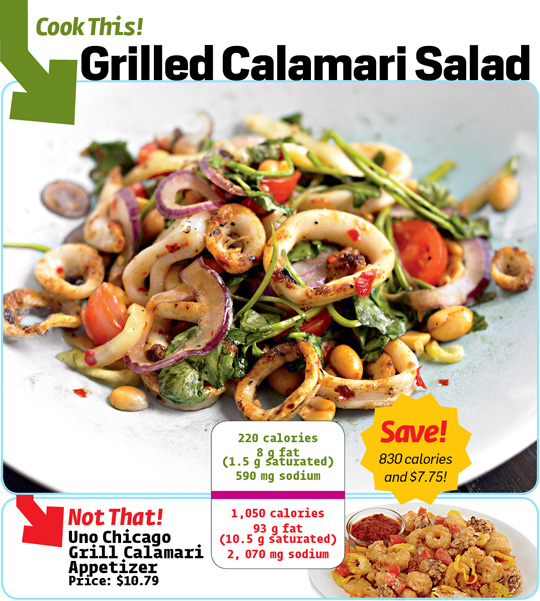
Squid is one of the most abundant forms of seafood in the global market, yet few Americans have ever enjoyed it in any other way than breaded and deep-fried, with a marinara chaser. With that type of treatment, it could be a Blooming Onion and you wouldn’t know the difference. This salad has all the trappings of the much-adored appetizer—crunch from the peanuts, tomatoes, a bit of spice—but so much more. We don’t want to promise that you’ll never go back to the fried stuff after this, but it’s a distinct possibility.
You’ll Need:
1 lb squid, cleaned, tentacles reserved for another use
½ Tbsp peanut or canola oil
Salt and black pepper to taste
Juice of 1 lime
1 Tbsp fish sauce
1 Tbsp sugar
½ Tbsp chili garlic sauce (preferably sambal oleek)
4 cups watercress*
1 small cucumber, peeled, seeded, and cut into matchsticks
1 medium tomato, chopped
½ red onion, very thinly sliced
¼ cup roasted peanuts
* Watercress isn’t always easy to find. Baby arugula or even a few big handfuls of fresh basil leaves, can easily take its place here.
How to Make It:
• Preheat a grill. Toss the squid bodies with the oil and generously season with salt and lots of black pepper. When the grill is very hot, add the squid and grill for about 5 minutes, until lightly charred all over.
• Combine the lime juice, fish sauce, sugar, and chili sauce in a mixing bowl and whisk to blend. Slice the grilled squid into ½" rings. In a salad bowl, toss the squid, watercress, cucumber, tomato, onion, and peanuts with the dressing. Divide the salad among 4 plates.
Makes 4 servings / Cost per serving: $3.04

Cooking Calamari
Grilling squid ranks right up there next to tying your shoes and making your bed in the difficulty category, yet most people are terrified of the prospect. Purchase whole squid bodies (available fully cleaned, fresh or frozen, at any decent fish market or quality grocery store) and either grill them whole over high heat for no more than 5 minutes, or cut them into rings and sauté in olive oil for the same amount of time.
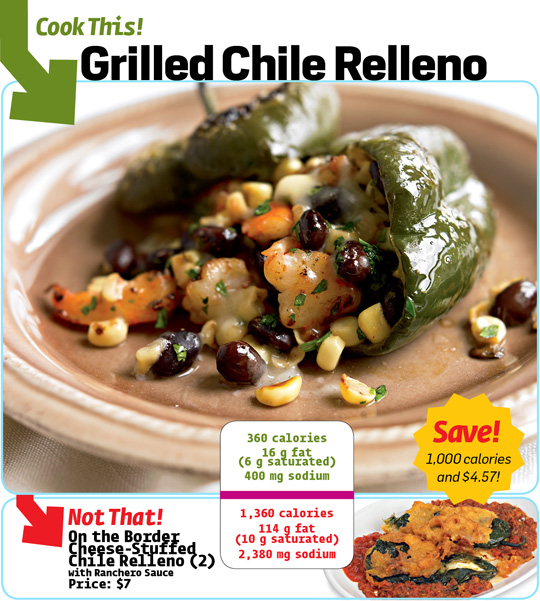
Traditionally, chiles rellenos require an amazing amount of work: roasting and peeling peppers, stuffing them, dipping them in egg wash, then deep-frying the pepper packages in a pot of oil. This recipe simplifies matters tremendously. Rather than go through all that labor, just cut off the tops, scoop in the stuffing, and pop them on the grill. You’ll save about 90 minutes of prep work, 20 minutes of cleanup, and a few hundred calories per pepper.
You’ll Need:
2 ears corn, shucked
½ Tbsp canola oil
8 oz cooked shrimp, chopped into ½" pieces
½ (14–16 oz) can black beans, drained
1 cup shredded Monterey Jack cheese
Juice of 1 lime
½ cup chopped cilantro
½ tsp cumin
Salt and black pepper to taste
8 poblano peppers
Salsa (optional)
How to Make It:
• Stand each ear of corn up vertically on a cutting board and run your knife along the ear to remove the kernels. Heat the oil in a large nonstick pan over medium heat. Add the corn and cook for about 5 minutes, until lightly toasted. Remove from the heat, then combine with the shrimp, beans, cheese, lime juice, cilantro, and cumin, plus salt and pepper.
• Preheat a grill or grill pan. Remove the tops of the peppers and scoop out the seeds. Use a spoon to stuff the shrimp mixture into each pepper cavity, being careful not to overfill.
• Place the peppers directly on the grill and cook for about 10 minutes, until the skins have lightly blistered and the flesh has softened. Serve with a bit of salsa, if you like.
Makes 4 servings / Cost per serving: $2.43

Poblano Peppers
These slender, knobby peppers are the reliable Goldilocks of the capsicum world, spicier than a green bell pepper, but sweeter and more subtle than a jalapeño. The balanced heat level makes them perfect for dozens of dishes: omelets, fajitas, stir-fries. Poblanos are available at most major supermarkets these days, but if you can’t find them or just don’t trust them, any bell pepper will do for this recipe.

One of the biggest trends to hit chain restaurants in the past year is the sudden proliferation of skewers and kebabs at places like Macaroni Grill, Olive Garden, and Red Lobster. It’s a move we fully applaud, since it means that the heavy carbs and fatty sauces that end up on most restaurant plates are being replaced with lean protein and vegetables. These kebabs have plenty of both, all punched up with an addictive Thai curry sauce that you’ll find yourself dipping everything in. Pineapple chunks would be a welcome addition here.
You’ll Need:
½ cup light coconut milk
2 Tbsp Thai red curry paste
1 Tbsp peanut butter
1 lb pork loin, cut into ¾" pieces
1 red or yellow bell pepper, chopped into large pieces
1 large red onion, chopped into large pieces
8 wooden skewers, soaked in water for 20 minutes*
* Soaking the skewers will keep them from catching fire on the hot grill.
How to Make It:
• Preheat a grill. Combine the coconut milk, curry paste, and peanut butter in a mixing bowl and stir to thoroughly blend. Transfer half to a separate bowl and reserve.
• Thread the pork, bell pepper, and onion onto the skewers, alternating between the meat and vegetables. Use a brush to paint the skewers with some of the remaining curry sauce. When the grill is hot, add the skewers and cook for 3 to 4 minutes per side, basting with a bit more of the sauce as you go. The skewers are done when the meat and vegetables are lightly charred and the pork is firm but still slightly yielding to the touch.
• Brush the kebabs with the reserved sauce before serving.
Makes 8 skewers / Cost per serving: $1.43
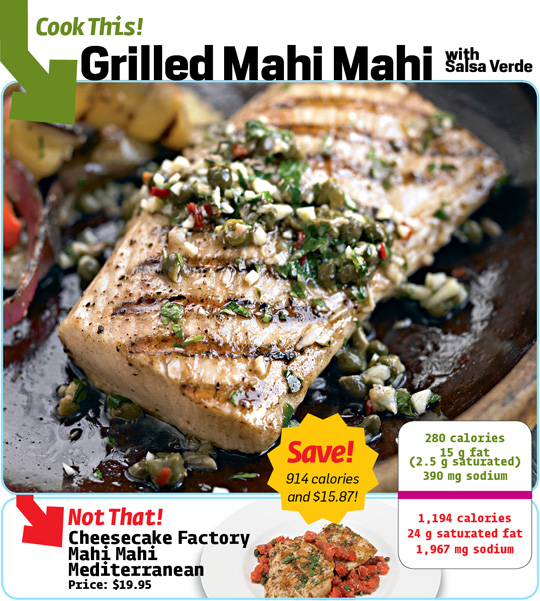
Confusingly enough, both Mexicans and Italians have their own salsa verde, and both are ridiculously good condiments that can be used in a staggering number of dishes. This, the Italian version, is based on parsley, anchovies, capers, and lemon juice, a bright herbal punch that pairs especially well with the smoke and char of a grill. Like Mexico’s version, this is equally good on meat as it is on fish. It’s no slouch on vegetables either. So make a big batch and keep it in the fridge for instant flavor upgrades.
You’ll Need:
¾ cup chopped fresh parsley
¼ cup chopped fresh mint (optional)
Juice of 1 lemon
¼ cup olive oil, plus more for grilling
2–3 anchovy fillets, minced
2 Tbsp capers, rinsed and chopped
2 cloves garlic, finely minced
Pinch of red pepper flakes
Salt and black pepper to taste
4 mahi mahi fillets, or other firm white fish like halibut, sea bass, or swordfish (about 6 oz each)
How to Make It:
• Preheat a grill. Make sure the grate is cleaned and oiled.
• Combine the parsley, mint if using, lemon juice, olive oil, anchovies, capers, garlic, and pepper flakes in a mixing bowl. Season with black pepper. Set the salsa verde aside.
• Rub the fish with a thin layer of oil, then season all over with salt and pepper. Place the fillets on the grill skin side down and grill for 5 minutes, until the skin is lightly charred and crisp and pulls away freely (if you mess with the fish before it’s ready to flip, it’s likely to stick). Flip and cook on the other side for 2 to 3 minutes longer, until the fish flakes with gentle pressure from your fingertip. Serve the fillets with the salsa verde spooned over the top.
Makes 4 servings / Cost per serving: $4.08

Crispy fish skin
Too often we peel off the skin from fish fillets and toss it, discarding one of the healthiest and tastiest parts of the fish. When properly cooked, skin provides a crisp textural counterpoint to the fish’s soft flesh. Whether cooking skin-on fillets on a grill or in a hot pan, start skin side down and cook for nearly 75 percent of the time on that side, then flip and finish on the flesh side. Not all fish have skin made to be crisped. While the skin of salmon, sea bass, and mahi are great eats, halibut, tilapia, and swordfish skin should be discarded (either before or after cooking).

Tacos should be a sure bet, regardless of the restaurant. Alas, not even this humble handheld street food is safe when caught in the clutches of the corporate chef. Excessive cheese and superfluous sauces ruin both the simple beauty of a taco and the nutritional integrity of a meal that should never top 500 calories. Our tacos get you back to the basics, with little more than a fiery marinade, toasted tortillas, and a scoop of salsa.
You’ll Need:
2 chipotle peppers in adobo
1 cup orange juice
1 tsp ground cumin*
2 cloves garlic
2 cups chopped fresh cilantro, plus more for garnish
1 lb flank steak
½ tsp salt
½ tsp pepper
8 corn tortillas
¼ cup guacamole
Salsa
1 red onion, minced
2 limes, quartered
* Cumin has been shown to help decrease the risk of colon, stomach, and liver cancers.
How to Make It:
• Combine the chipotle, orange juice, cumin, garlic, and cilantro in a blender and puree. Place the steak and marinade in a resealable plastic bag and refrigerate for 30 minutes or up to 8 hours.
• Remove the steak from the marinade. Season with salt and pepper. Heat a grill, stovetop grill pan, or cast-iron skillet until hot. Cook the steak for 3 to 4 minutes per side (for medium rare).
• Heat the tortillas until warm and pliable. It’s best to do this on a hot grill or cast-iron skillet, but in a pinch, wrap the tortillas in a damp paper towel and microwave for 45 seconds.
• Slice the steak across the grain into thin pieces and divide among the tortillas. Top with guacamole, salsa, onion, extra cilantro, and a squirt of lime juice.
Makes 4 servings / Cost per serving: $3.69

Chicken breast may still be king of the American meat market, but pork tenderloin is no less worthy of the crown. Besides being nearly as lean as white meat chicken (a 3-ounce portion of cooked pork tenderloin has only 3 grams of fat), pork also boasts an impressive array of nutrients, including more than a third of a day’s dose of selenium, a trace min-eral shown to be effective in cancer prevention. Another reason to love pork is its ability to stand up to big, gutsy flavors. Here, a heady rub of mustard and chili powder and a powerful salsa of pineapple and jalapeño help skyrocket the flavor quotient while adding only about 25 calories—plus a tide of first-rate nutrients—to the bottom line.
You’ll Need:
1 Tbsp Dijon or grainy mustard
½ Tbsp honey
½ Tbsp chili powder
Salt and black pepper to taste
1 lb pork tenderloin
4 (½"-thick) slices pineapple, core removed
1 red onion, minced
1 jalapeño pepper, minced
½ cup chopped fresh cilantro
Juice of 1 lime
How to Make It:
• Preheat the grill. Combine the mustard, honey, chili powder, and a good sprinkle of salt and pepper and rub all over the pork. Place the pork and pineapple slices on the grill. Grill the pineapple for 2 to 3 minutes per side, until lightly charred and softened. Grill the tenderloin, turning once or twice, for about 10 minutes, until lightly charred and firm (but yielding) to the touch (an internal thermometer should read no more than 160°F). Let the pork rest for at least 5 minutes.
• While the pork rests, chop the pineapple into bite-size pieces. Combine with the onion, jalapeño, cilantro, and lime juice. Season with a bit of salt and pepper. Slice the pork and serve with the salsa.
Makes 4 servings / Cost per serving: $2.28

Fruit salsa
Nothing impresses more and requires less than a fruit salsa. Start with the same base—1 minced onion, 1 minced jalapeño, ½ cup chopped cilantro, and the juice of a lime—and then add the fruit of your choice. Mango and papaya are obvious choices, but apples, melon, and even strawberries work beautifully as well.

Lamb has long been a second-class citizen in American households, a meat you turn to maybe once a year when you’ve grown tired of chicken and beef. Too bad, since lamb is not only jam-packed with flavor and easy to cook, but surprisingly lean when you work with the right cuts. (The notion that lamb is “gamey” doesn’t hold true anymore, partially because most lamb is so lean.) Though tzatziki, a Greek-style yogurt sauce, matches perfectly with a charred lamb chop, it also can—and should—be applied to grilled chicken, pork, and fish on a frequent basis.
You’ll Need:
1 cucumber, peeled, halved, and seeded
1 cup Greek-style yogurt (we like Fage)
Juice of 1 lemon
2 Tbsp olive oil
2 cloves garlic, finely minced
2 tsp minced fresh dill
Salt and black pepper to taste
4 loin or shoulder lamb chops (about 4 oz each)
How to Make It:
• Preheat a grill. Grate the cucumber with a cheese grater, then use your (clean!) hands to wring out all the excess water. Combine the cucumber with the yogurt, lemon juice, half the olive oil, garlic, dill, and a good pinch of salt and pepper. Set the tzatziki aside.
• Rub the lamb with the remaining olive oil, then season all over with salt and pepper. Grill, turning once, until a meat thermometer inserted into the deepest part of a chop reads 135°F, 10 to 12 minutes, depending on the thickness of the cut. Serve with the tzatziki.
Makes 4 servings / Cost per serving: $3.75

Beautiful, perfectly trimmed loin lamb chops come with a steep price tag, often fetching up to $15 or more a pound. Many supermarkets sell individual shoulder chops, though, for about half the price, and they work every bit as well in this recipe. The same could be said about leg of lamb, which goes for about $6 a pound and proves to be an amazing cut for both roasting in the oven and tossing on the grill. Bottom line: Don’t pass on lamb because you can’t afford the priciest cut.
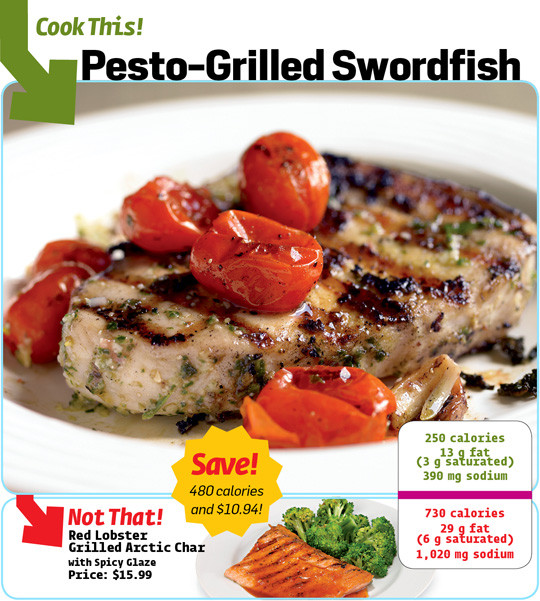
No fridge should be without a bottle of premade pesto. It pairs perfectly with pasta, of course, but also works as an excellent sandwich spread, salad dressing enhancer, and instant marinade. This recipe takes the latter tack, slathering meaty swordfish steaks in pesto before grilling, then topping them with quick-sautéed tomatoes. The burst of sweetness from the tomatoes joins forces with the garlicky punch of the pesto, making for a dish that tastes every bit the creation of a restaurant chef.
You’ll Need:
2 Tbsp bottled pesto
4 swordfish steaks (4–6 oz each)*
1 Tbsp olive oil
2 cloves garlic, peeled and lightly crushed
2 cups cherry tomatoes
Salt and black pepper to taste
* Swordfish steaks are bulky, between 10 and 16 ounces, so plan on buying 2 smallish steaks and cutting them in half.
How to Make It:
• Spread the pesto all over the swordfish steaks, cover, and marinate in the fridge for 30 minutes.
• While the fish marinates, heat the olive oil in a sauté pan over medium heat. Add the garlic and cook for a minute or two, until lightly browned. Add the tomatoes and sauté until the skins are lightly blistered and about to pop, about 5 minutes. Season with salt and pepper.
• Preheat a grill or grill pan. Season the fish all over with salt and pepper. When the grill is hot, cook the swordfish for 4 to 5 minutes per side, until the fish is cooked all the way through and the flesh flakes with gentle pressure. Reheat the tomatoes and top each steak with a scoop.
Makes 4 servings / Cost per serving: $5.05

Greater Grains
American eating traditions dictate that every homecooked meal come with a starch, which usually means potatoes or rice, neither of which add much to a meal other than empty carbs. But a new class of global grains has flooded the market that can boost nutrition and cut calories. Quinoa, from South America, is our favorite, but also try amaranth, couscous, and farro. All are excellent high-fiber rice and potato alternatives.

In the Shinjuku district of Tokyo, behind the central train station (the busiest in the world), you’ll find a long, narrow alleyway—appropriately dubbed Yakitori Alley—that is lined with dozens of tiny bars and stands billowing savory smoke into the air. Humble grill masters expertly char skewered food of all shapes and sizes: plump meatballs, tiny cherry tomatoes, even pure chicken skin that crisps up like potato chips. Though we never had this exact kebab there, the flavors are true to the spirit of Yakitori Alley; we hope the grill masters would approve.
You’ll Need:
2 Tbsp hoisin sauce
1 Tbsp low-sodium soy sauce
2 tsp dark or toasted sesame oil
1 tsp chili sauce or paste, such as sriracha
1 lb sirloin, cut into ¾" pieces
8 scallion whites, chopped into ½" chunks
20 small mushroom caps
20 cherry tomatoes
8 wooden skewers, soaked in water for 20 minutes
How to Make It:
• Preheat a grill. Combine the hoisin, soy sauce, sesame oil, and chili sauce in a bowl and mix thoroughly. Transfer half to a separate bowl and reserve.
• Thread the beef, scallion whites, mushrooms, and cherry tomatoes onto the skewers, alternating between the meat and vegetables. Use a brush to paint the skewers with some of the remaining hoisin glaze. When the grill is hot, add the skewers and cook for 3 to 4 minutes per side, basting with a bit more of the sauce as you go. The skewers are done when the meat and vegetables are lightly charred and the beef is firm but still yielding to the touch.
• Brush the kebabs with the reserved glaze before serving.
Makes 4 servings / Cost per serving: $1.61

Improving sauces
Making a killer sauce for the grill on the fly is easier than most think. Start with a base with a well-rounded flavor: Ketchup, Dijon, hoisin all work. Then mix in other liquids or condiments that add strong single flavor notes: honey for sweetness, vinegar for acid, soy sauce for salt, sriracha for heat. Finally, turn to the spice cabinet to bring it all together. Chili powder, garlic and onion salt, cumin, brown sugar, mustard powder, and cayenne are all common elements of barbecue sauces and all could be the finishing touch for your next masterpiece.

The supermarket is flooded with mediocre jerk marinades that lack the punch—the gutsiness—of real jerk cooking as done by the pit masters that pepper the Jamaican coastal communities. To get it right, one needs a small stash of fiery habanero or Scotch bonnet peppers, which, although they have become commonplace in supermarkets, still need to be treated with caution when prepping and eating. To give you an idea of their power, a jalapeño is rated at 5,000 Scoville units (the accepted measurement for spiciness); a habanero rates at 350,000. Proceed with caution.
You’ll Need:
2 habanero or Scotch bonnet peppers, stemmed and roughly chopped*
8 scallions, roughly chopped
Juice of 2 limes
2 Tbsp canola oil
3 cloves garlic, chopped
1 tsp allspice
¼ tsp nutmeg
Salt and black pepper to taste
1 lb pork loin
* Either use gloves or limit exposure to skin by using tongs to help you handle the pepers.
How to Make It:
• Place the habaneros, scallions, lime juice, oil, garlic, allspice, nutmeg, and a good pinch of salt and pepper in a food processor. Pulse until the mixture forms a paste with the consistency of pesto, adding a bit of water if it’s too dry.
• Place the pork (chicken drumsticks work great, too) in a sealable plastic bag and pour the jerk marinade over it. Squeeze out the air, seal the bag, and rub the pork around to make sure it’s evenly coated. Marinate in the refrigerator for at least 1 hour, but preferably overnight.
• Preheat a grill. Remove the pork from the marinade and season with a bit more salt and pepper. Grill, cooking on all sides, for about 10 minutes, until lightly charred and cooked through. (An internal thermometer inserted into the center of the pork will read 140°F.)
Makes 4 servings / Cost per serving: $2.23

This is the type of recipe you want to make a lot of, not just because its fiery bite is addictive right off the grill, but also because leftovers straight from the fridge make incredible dishes the next day. Toss hunks of cold pork with romaine, mango, shredded carrot, peanuts, and a simple vinaigrette. Or make a sandwich filling for the ages: Slice the pork thinly, then top with slowly caramelized onions, roasted peppers, and melted Swiss cheese.